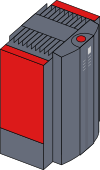projekt:rudel:grovinventering:riemann
Modell: Cray Y-MP EL-94
Introduktionsår: 1992
Tillverkare: Cray
Signifikans: Riemann användes för forskning inom kaosteori och innan dess användes den av Lotus Cars.
Historia: Matematiska institutionen vid Uppsala universitet köpte denna av Lotus Cars
Donator: Matematiska institutionen
Tillbehör: Dokumentation
Kontaktperson(er): Dennis A. Hejhal
Länkar till Dennis hemsidor (som omnämner Riemann och visar bilder):
Utvalda bilder:
Länk till UNT om utställningen på gustavianum:
Plakat som användes vid utställningen “Tre ton minidatorer”:
Information från Dennis:
Information about "Riemann"
===========================
(I) Machine Specifications.
CRAY YMP-EL4/1024
(serial number: SN 5125)
The YMP-EL4/1024 was a parallel-vector machine having
a maximum speed of 532 million operations per second.
4 processors
1 Gigabyte (1024 Megabytes) of memory for use in codes
24 Gigabyte disk storage
Operated: October 1996 thru April 2001
by Prof. Dennis Hejhal's research group in the Uppsala
University Mathematics Department
Total Purchase Price: approximately 700000 SEK
(about 400k for the hardware, 300k for the software,
all paid for via a grant from NFR, i.e. current-day VR)
Donated to the Update Computer Club: mid-April 2001
Machine age in 1996: about 4 years old
Previous Owner: LOTUS Sports Cars Co. in UK
Software: Fortran77, Cray Fortran, Fortran 90, C, C++,
MAPLE, PVM, Cray Message Passing Toolkit (MPT)
Operating System: UNICOS (like Unix)
Clock period: 30 nanoseconds (33 Megaherz)
-------------------------------------------------------------
The machine's architecture allows, due to vectorization,
a peak performance per processor of 4 floating point
operations per clock period, which equates to 133 megaflops
(i.e., 133 million floating point operations per second).
Programs could also be run utilizing all 4 processors
in parallel. For this, Riemann was equipped with both
a) Cray microtasking/autotasking software [for "fine-grained"
parallelism of do-loops];
b) PVM and MPT [for "large-scale" parallelism within codes].
Used in parallel, the theoretical maximum speed was thus 532
megaflops. In practice, on a good parallel code with lots of
numerical calculation (as opposed to i/o), Riemann ran about
10% faster than one CRAY-XMP processor, and frequently as fast
as one (mainframe) YMP processor.
The following "per processor" table offers a comparison with other
1990s-era parallel-vector machines manufactured by Cray:
XMP - 8.5 nanosecond (117 Mhz) clock, 2 results per clock: 234 Mflops
YMP - 6.0 nanosecond (166 Mhz) clock, 2 results per clock: 333 Mflops
J90 -10.0 nanosecond (100 Mhz) clock, 2 results per clock: 200 Mflops
C90 - 4.16 nanosecond (240 Mhz) clock, 4 results per clock: 960 Mflops
EL - 30.0 nanosecond (33 Mhz) clock, 4 results per clock: 133 Mflops
Two machines here give 4 results per clock: the C90 does this via dual
vector pipes (all vectors run at 2 results per clock); the Y-MP EL
gets this from 4 independent functional units.
(II) Scientific Information.
During 1996-2001, Riemann was heavily used in Dennis Hejhal's Uppsala
University research group on analytic number theory and quantum chaos.
Notable experiments carried out on Riemann include:
a) The detailed calculation of numerous quantum "vibrational" states
linked to either prime number symmetries or lattices in negatively curved
space. For several years, Riemann held the world-record in the obtaining
the states of highest energy in each context.
b) The first-ever calculation of what are called "L-functions" associated
with such quantum states. These functions help mathematicians understand
how much randomness is present in the associated vibrational pattern. This,
in turn, has important connections with the distribution of the prime numbers.
In order to obtain these results, it was not uncommon that Riemann needed to
run in dedicated mode (i.e., uninterruptedly) for one week or more.
In addition to Hejhal, researchers involved in this work included Helen
Avelin, Fredrik Stromberg, Andreas Strombergsson, and Holger Then.
5/31/2012
projekt/rudel/grovinventering/riemann.txt · Last modified: 2021/05/27 19:39 by pontus

